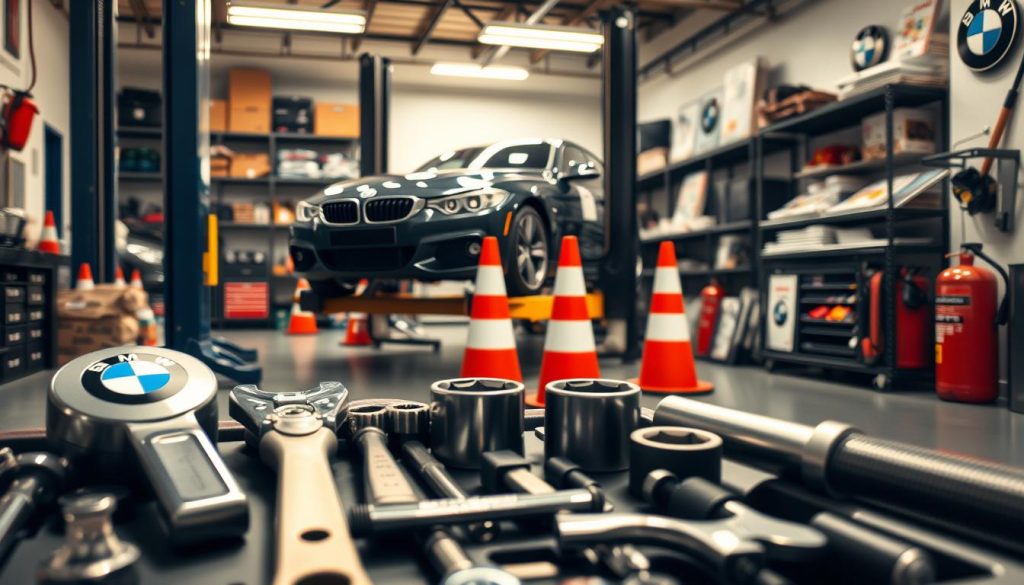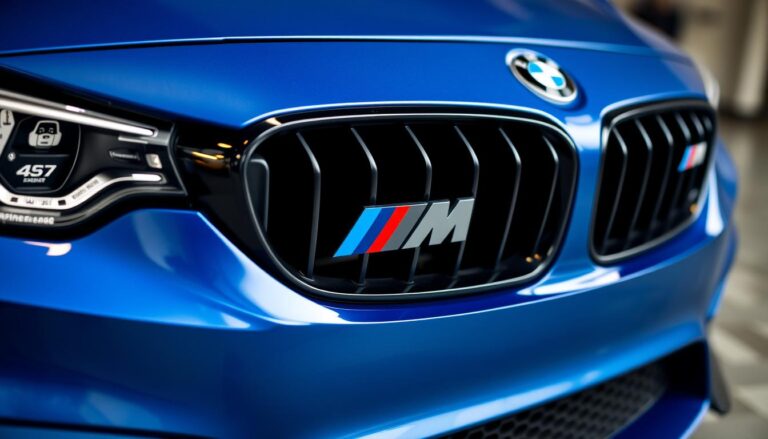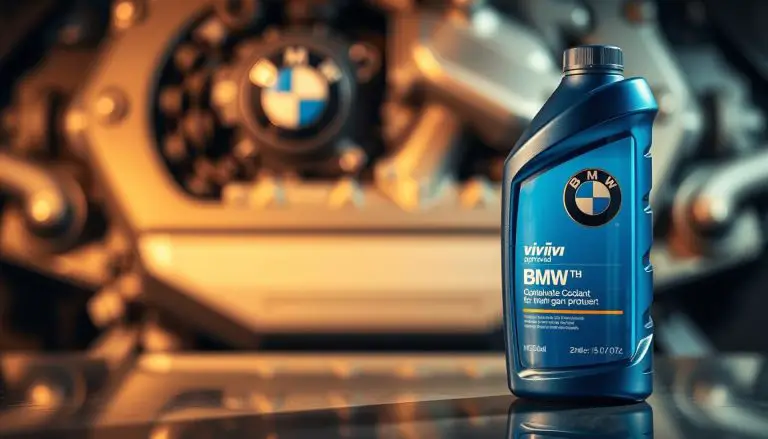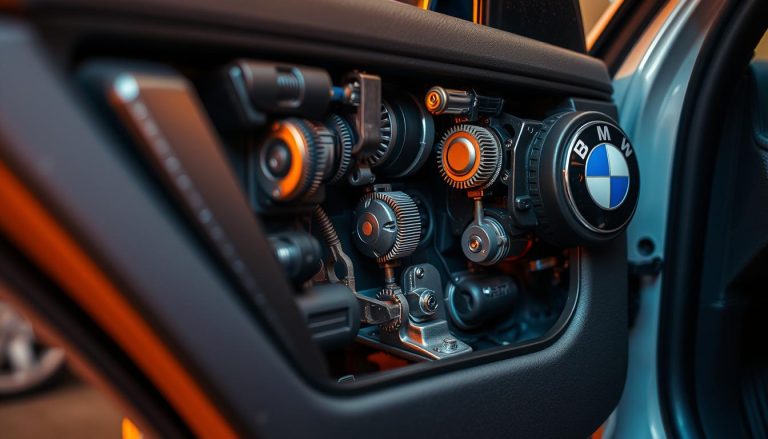The scenario where your BMW fails to initiate but retains power is not only vexing but also enigmatic. This predicament can arise from a multitude of factors, spanning from minor electrical malfunctions to intricate mechanical maladies.
Accurately pinpointing the underlying cause is paramount for an expedient resolution. A precise diagnosis not only expedites the repair process but also averts the expenditure of resources on unwarranted interventions, ensuring your vehicle’s swift return to functionality.
This exhaustive manual will guide you through the diagnostic and potential corrective measures, offering a profound comprehension of the potential malfunctions plaguing your vehicle.
Key Takeaways
- Identify common causes of BMW starting problems.
- Learn the importance of correct diagnosis.
- Understand the steps to potentially fix the issue.
- Discover how to prevent unnecessary repairs.
- Get back on the road with your BMW.
Understanding When Your BMW Won’t Start But Has Power
The scenario where a BMW exhibits power but fails to initiate start-up necessitates a thorough examination of the underlying causes. This enigmatic situation, though challenging, can be deciphered by identifying the root issues. Such knowledge is pivotal in diagnosing and potentially rectifying the problem.
What “Has Power But Won’t Start” Actually Means
The expression “has power but won’t start” signifies that the electrical systems within the vehicle are operational, yet the engine refuses to commence. This predicament can stem from a multitude of factors, including battery malfunctions or more intricate problems with the ignition or fuel systems. Understanding the symptoms is fundamental to resolving the issue at hand.
The term “has power” implies that the vehicle’s accessories, such as the radio, lights, and dashboard, are functioning correctly. Yet, when attempting to initiate the engine by turning the key or pressing the start button, it remains inert. This distinction is paramount in streamlining the potential causes.
Common Symptoms to Look For in BMW Vehicles
In diagnosing a BMW that exhibits power but fails to start, several symptoms warrant attention. These include:
- Clicking sounds when turning the key
- Dashboard warning lights or error messages
- Dim or flickering headlights
- No response when pressing the start button
Recognizing these symptoms aids in narrowing down the potential causes. For example, a clicking sound may indicate a malfunctioning starter motor, whereas dim headlights could suggest a battery-related issue.
| Symptom | Possible Cause |
|---|---|
| Clicking sound when turning the key | Faulty starter motor or solenoid |
| Dashboard warning lights | Issue with the ignition or fuel system |
| Dim or flickering headlights | Battery or alternator problem |

Essential Tools and Safety Precautions
To effectively diagnose and repair a BMW that won’t start, understanding the essential tools and safety measures is paramount. Before diving into complex diagnostic procedures, it’s vital to ensure you have the right equipment and follow necessary safety protocols to avoid injury or further damage to your vehicle.
Tools You’ll Need for BMW Diagnosis and Repair
Having the correct tools is fundamental when diagnosing issues with your BMW. Essential tools include a high-quality OBD-II scanner, a multimeter for electrical system checks, and a set of insulated screwdrivers. For more in-depth repairs, a BMW-specific diagnostic tool can be invaluable.
| Tool | Purpose |
|---|---|
| OBD-II Scanner | Reading trouble codes and monitoring engine performance |
| Multimeter | Checking voltage and continuity in electrical circuits |
| Insulated Screwdrivers | Protecting against electrical shock during repairs |
Safety Measures When Working on Your BMW
Safety should always be your top priority when working on your vehicle. Ensure you’re wearing protective gear such as gloves and safety glasses. Be cautious of electrical components and avoid short circuits. It’s also crucial to follow proper lockout/tagout procedures for safety when working with electrical systems.

Initial Diagnostic Steps for Your BMW
Diagnosing a BMW that refuses to start yet exhibits power necessitates a meticulous methodology to uncover the underlying cause. This entails a series of preliminary diagnostic procedures aimed at identifying the root issue.
Performing a Basic Power Check
The initial step involves a basic power assessment. Verify the integrity of your BMW’s battery and the cleanliness and security of its connections. A straightforward battery voltage examination can be conducted with a multimeter.
Listening for Telling Sounds When Turning the Key
Upon key-turning, attentively listen for any anomalous sounds. A clicking noise might signify a malfunction in the starter motor or solenoid, whereas an absence of sound could indicate a more profound electrical problem.
Checking Dashboard Warning Lights and Error Messages
Modern BMWs are equipped with advanced diagnostic systems that display warning lights and error messages on the dashboard. Inspect your dashboard for any illuminated warning lights or messages that could offer insights into the problem.
Adhering to these initial diagnostic steps enables the collection of crucial information regarding your BMW’s reluctance to start despite exhibiting power. This information is pivotal in guiding the subsequent steps towards resolving the issue.
Battery-Related Issues in BMWs
The battery’s role in initiating your BMW’s operation is paramount, and malfunctions can precipitate vexing no-start scenarios. Battery-related maladies can manifest in a spectrum of forms, ranging from a mere dead battery to more intricate problems encompassing the battery’s state and its connections.
Testing Battery Voltage and Condition
To pinpoint battery-related maladies, initiate by conducting a battery voltage and condition assessment. A battery in optimal charge should register approximately 12.6 volts when evaluated with a multimeter. A significantly lower reading may signify a depleted or defective battery.
A battery load test serves to evaluate the battery’s condition by simulating the engine start load. This evaluation can ascertain if the battery sustains its voltage under load; a pronounced drop suggests the need for replacement.
Inspecting Battery Connections and Terminals
Corrosion or loose connections at the battery terminals can impede the battery’s functionality. Examine the terminals for corrosion or wear, and clean them if necessary. Verify that the connections are securely fastened.
| Connection Type | Inspection Criteria | Action Required |
|---|---|---|
| Positive Terminal | Corrosion, Wear | Clean or Replace |
| Negative Terminal | Corrosion, Wear | Clean or Replace |
BMW-Specific Battery Registration Procedures
Post-replacement of a battery in a contemporary BMW, it is imperative to execute battery registration to apprise the vehicle’s computer (DME/ECU) of the new battery’s specifications. This procedure ensures proper charging and peak performance.
“Battery registration is a critical step after replacing the battery in your BMW. It helps the vehicle’s systems adjust to the new battery, ensuring reliable starting and optimal electrical system performance.” – BMW Service Manual
Registration necessitates the utilization of specialized tools or software, such as BMW’s ISTA or a third-party equivalent. Adherence to the manufacturer’s guidelines for registration is paramount to circumvent potential electrical system malfunctions.
Starter Motor Problems and Solutions
The starter motor is a critical component to investigate when your BMW won’t start but has power. A faulty starter motor can be frustrating, but understanding the signs and knowing how to test and replace it can get your BMW back on the road.
Signs of a Failing Starter Motor in BMW Models
Identifying a failing starter motor early can save you from being stranded. Common signs include a clicking sound when turning the key, slow cranking, or no cranking at all. If you notice any of these symptoms, it’s essential to investigate further.
Key indicators of a failing starter motor:
- Clicking noise when turning the ignition key
- Slow or labored engine cranking
- No response when attempting to start the engine
Testing Your BMW’s Starter Motor and Solenoid
Testing the starter motor involves checking the voltage drop across the starter motor circuit and inspecting the solenoid for proper function. A multimeter is essential for these tests. Ensure your safety by disconnecting the battery before starting any tests.
According to
“Automotive Repair Manual” by Chilton, ‘a voltage drop test can help identify if there’s excessive resistance in the starter circuit’.
This can be a crucial step in diagnosing starter motor issues.
Replacing the Starter Motor Step-by-Step
Replacing the starter motor in a BMW requires some mechanical aptitude and the right tools. Start by disconnecting the battery to prevent any accidental starts. Then, locate and remove the starter motor, taking care not to damage surrounding components.
Steps to replace the starter motor:
- Disconnect the negative battery cable
- Locate the starter motor and remove any obstructing components
- Disconnect electrical connectors to the starter motor
- Remove the starter motor mounting bolts and pull out the starter
- Install the new starter motor in reverse order of removal
Ignition System Troubleshooting
The ignition system is integral to your BMW’s starting mechanism, and its malfunction can unveil the underlying problem. A fully operational ignition system is essential for your vehicle’s optimal functioning.
Checking the Ignition Switch and Key Fob
The ignition switch and key fob are fundamental to your BMW’s ignition system. To assess the ignition switch, confirm its operational integrity and absence of wear. Regarding the key fob, ascertain the battery’s status and the fob’s synchronization with your vehicle.
Inspecting Ignition Coils and Spark Plugs
Ignition coils and spark plugs are indispensable for sparking your BMW to life. Inspect the ignition coils for any wear or damage indicators, and examine the spark plugs for fouling or deterioration. Replacement of faulty components can rectify starting malfunctions.
BMW-Specific Ignition Issues by Series
Various BMW series may encounter unique ignition system challenges. For example, certain models might be susceptible to ignition switch failures or necessitate specific key fob programming. Familiarity with these series-specific issues aids in diagnosing and rectifying your BMW’s ignition system problems.
Through meticulous ignition system troubleshooting, you can pinpoint and possibly resolve the issue hindering your BMW’s start-up.
Fuel System Diagnosis and Repair
A malfunctioning fuel system can prevent your BMW from starting, even when it has power. The fuel system is responsible for delivering fuel to the engine, and any issues within this system can lead to starting problems.
Testing the Fuel Pump and Pressure Regulator
The fuel pump is a critical component of the fuel system, responsible for pressurizing the fuel lines. Testing the fuel pump involves checking its electrical circuit and ensuring it’s functioning correctly. You can use a multimeter to check the voltage at the fuel pump connector when the ignition is turned on. Listening for the humming noise of the fuel pump when the key is turned can indicate if it’s working.
Steps to test the fuel pump:
- Check the fuel pump relay and fuse
- Listen for the fuel pump’s humming noise
- Use a multimeter to check voltage at the fuel pump connector
Checking Fuel Pressure and Injectors
Fuel pressure is another crucial aspect of the fuel system. Low fuel pressure can prevent the engine from starting. You can use a fuel pressure gauge to check the pressure in the fuel system. Inspecting the fuel injectors for cleanliness and proper function is essential, as clogged injectors can prevent the engine from getting the fuel it needs.
Signs of faulty fuel injectors include:
- Poor engine performance
- Decreased fuel efficiency
- Engine misfires
Common BMW Fuel System Failures by Model
Different BMW models can experience unique fuel system issues. For instance, some models may be prone to fuel pump failures, while others might have issues with the fuel pressure regulator. Understanding these model-specific issues can help in diagnosing and repairing fuel system problems.
Some common issues include:
| Model | Common Fuel System Issue |
|---|---|
| E46 (3 Series) | Fuel pump failure |
| E90 (3 Series) | Fuel pressure regulator issues |
BMW Won’t Start But Has Power: Electrical System Issues
The electrical system’s integrity is paramount when a BMW exhibits a failure to start yet retains power. This scenario presents a myriad of diagnostic challenges, yet a systematic approach can uncover the root cause.
Examining Fuses and Relays in BMW Vehicles
In the realm of BMW’s electrical system, fuses and relays are indispensable. A malfunctioning fuse or relay can impede the vehicle’s ability to start. Initiating the diagnostic process involves inspecting the fuse box for any signs of blown fuses pertinent to the starting mechanism. Utilizing a multimeter, one can assess the integrity of these components. Replacing a blown fuse or faulty relay often rectifies the problem at hand.
Diagnosing Control Module Problems (DME/ECU)
The Digital Motor Electronics (DME) or Engine Control Unit (ECU) serves as the central nervous system of your BMW’s engine management system. A malfunction in this critical component can hinder engine startup. Indicators of failure include error codes and anomalous behavior. Employing diagnostic tools is essential to ascertain the control module’s functionality. In some instances, reprogramming or replacement of the DME/ECU may be imperative.
Wiring Harness Inspection and Common Failure Points
The wiring harness is a fundamental element of the electrical system. Prolonged exposure to environmental stressors can lead to wire damage. Inspect the wiring harness for any signs of deterioration or corrosion, focusing on areas susceptible to heat or moisture. Repairing or replacing damaged wiring can address the starting issues at hand.
As
“The complexity of modern automotive electrical systems demands a thorough and methodical approach to diagnosis.”
Through a systematic evaluation of fuses, relays, control modules, and wiring, one can pinpoint and rectify the electrical system’s malfunction, thus enabling the BMW to start.
Using Diagnostic Tools for BMW Starting Problems
To diagnose why your BMW won’t start, specialized diagnostic tools are essential. These tools are designed to uncover issues within the intricate systems of your vehicle.
OBD-II Scanner Basics for BMW Vehicles
An OBD-II scanner is a critical tool for diagnosing BMW starting problems. It connects to your vehicle’s OBD-II port, usually found under the steering column. Modern OBD-II scanners can read trouble codes, monitor real-time data, and even perform advanced functions like coding and programming for BMWs.
Interpreting BMW-Specific Error Codes Related to Starting Issues
When utilizing an OBD-II scanner on your BMW, deciphering the error codes it provides is imperative. BMW-specific codes can indicate issues with the starter motor, battery, or ignition system. For instance, codes related to the DME (Digital Motor Electronics) or ECU (Engine Control Unit) can signify problems with the engine control module.
| Error Code | Description | Possible Cause |
|---|---|---|
| 2C7F | Fault in DME | Faulty DME or wiring issue |
| 2C6C | Fault in Lambda probe | Faulty Lambda probe or exhaust issue |
Preventive Maintenance to Avoid Future Starting Issues
Engaging in regular maintenance is pivotal in mitigating the onset of starting malfunctions in your BMW. By diligently adhering to routine inspections, one can preemptively uncover potential issues, averting their escalation into significant problems.
Regular Battery Maintenance for BMWs
Maintaining the integrity of your BMW’s battery necessitates regular inspections of the battery terminals for signs of corrosion and verifying the battery’s securement. It is advisable to assess the battery’s age and contemplate replacement every 5-7 years or as stipulated by the manufacturer’s guidelines.
Scheduled Service Intervals for Ignition and Fuel Systems
Compliance with the prescribed service schedule for your BMW’s ignition and fuel systems is crucial in averting starting malfunctions. This entails regular spark plug replacements and fuel system cleanings. Refer to your owner’s manual for precise instructions on service intervals.
Conclusion
Diagnosing and repairing a BMW that won’t start but has power is a complex endeavor, encompassing numerous potential causes and solutions. This article has dissected the critical steps to pinpoint and rectify the underlying issue. These steps range from rudimentary power checks and battery inspections to sophisticated diagnostic methodologies employing specialized tools.
Grasping the symptoms, such as clicking sounds or dashboard warning lights, and applying the diagnostic tips provided, empowers BMW owners to effectively troubleshoot their vehicle’s starting malfunctions. Adherence to regular maintenance, including battery checks and adherence to scheduled service intervals for ignition and fuel systems, is paramount in averting future problems.
To achieve a comprehensive BMW starting problems solution, a meticulous diagnostic approach is imperative. This involves a thorough examination of all potential causes, from battery and starter motor malfunctions to electrical system defects. Such diligence ensures a successful BMW repair conclusion, restoring your vehicle’s functionality with utmost efficiency.
FAQ
What are the common reasons why a BMW won’t start but has power?
Issues with the battery, starter motor malfunctions, ignition system defects, and problems within the fuel system are prevalent causes.
How do I test the battery voltage of my BMW?
Employ a multimeter to measure the voltage across the battery terminals. A fully charged battery should exhibit a voltage of approximately 12.6 volts.
What are the signs of a failing starter motor in a BMW?
Indicators include a clicking sound upon key turn, slow cranking, or complete lack of cranking.
How do I diagnose ignition system issues in my BMW?
Inspect the ignition switch, key fob, ignition coils, and spark plugs for any signs of wear or damage.
What is the procedure for registering a new battery in a BMW?
Utilize a BMW-specific OBD-II scanner or consult a dealership to register the new battery and reset the battery management system.
Can I use a generic OBD-II scanner to diagnose BMW starting problems?
While a generic OBD-II scanner can be employed, a BMW-specific scanner is advisable for more precise and detailed diagnostics.
How often should I perform routine maintenance on my BMW’s battery?
Inspect the battery terminals for corrosion every 6 months and have the battery tested every 3-5 years or as recommended by the manufacturer.
What are the scheduled service intervals for the ignition and fuel systems in a BMW?
Refer to your owner’s manual or a dealership for the recommended service schedule, as it varies by model and year.
Can a faulty control module (DME/ECU) prevent my BMW from starting?
Yes, a faulty control module can cause starting issues, and diagnosis may require specialized tools and expertise.
How do I inspect the wiring harness for common failure points in my BMW?
Examine for signs of wear, damage, or corrosion in areas prone to stress or heat, such as near the engine or under the dashboard.


